Pitching and Negotiation
VerifiedAdded on 2020/12/09
|9
|2354
|89
Essay
AI Summary
This essay examines the importance of pitching and negotiation skills in business development. It explores the key steps and information required for successful negotiation, including preparation, discussion, clarifying goals, and achieving win-win outcomes. The essay also delves into the RFP process, contractual processes, and the management of relevant documentation.
Contribute Materials
Your contribution can guide someone’s learning journey. Share your
documents today.
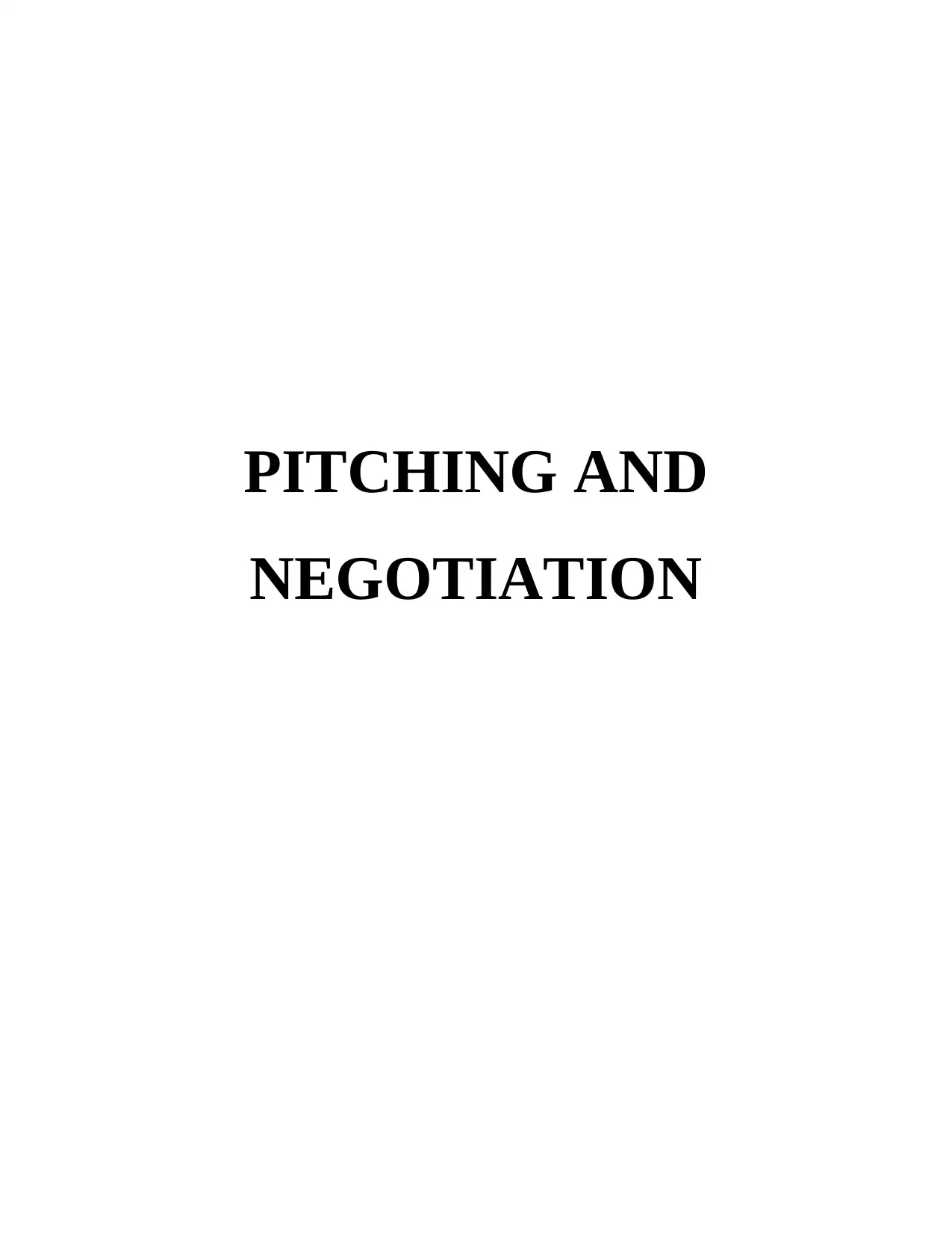
PITCHING AND
NEGOTIATION
NEGOTIATION
Secure Best Marks with AI Grader
Need help grading? Try our AI Grader for instant feedback on your assignments.

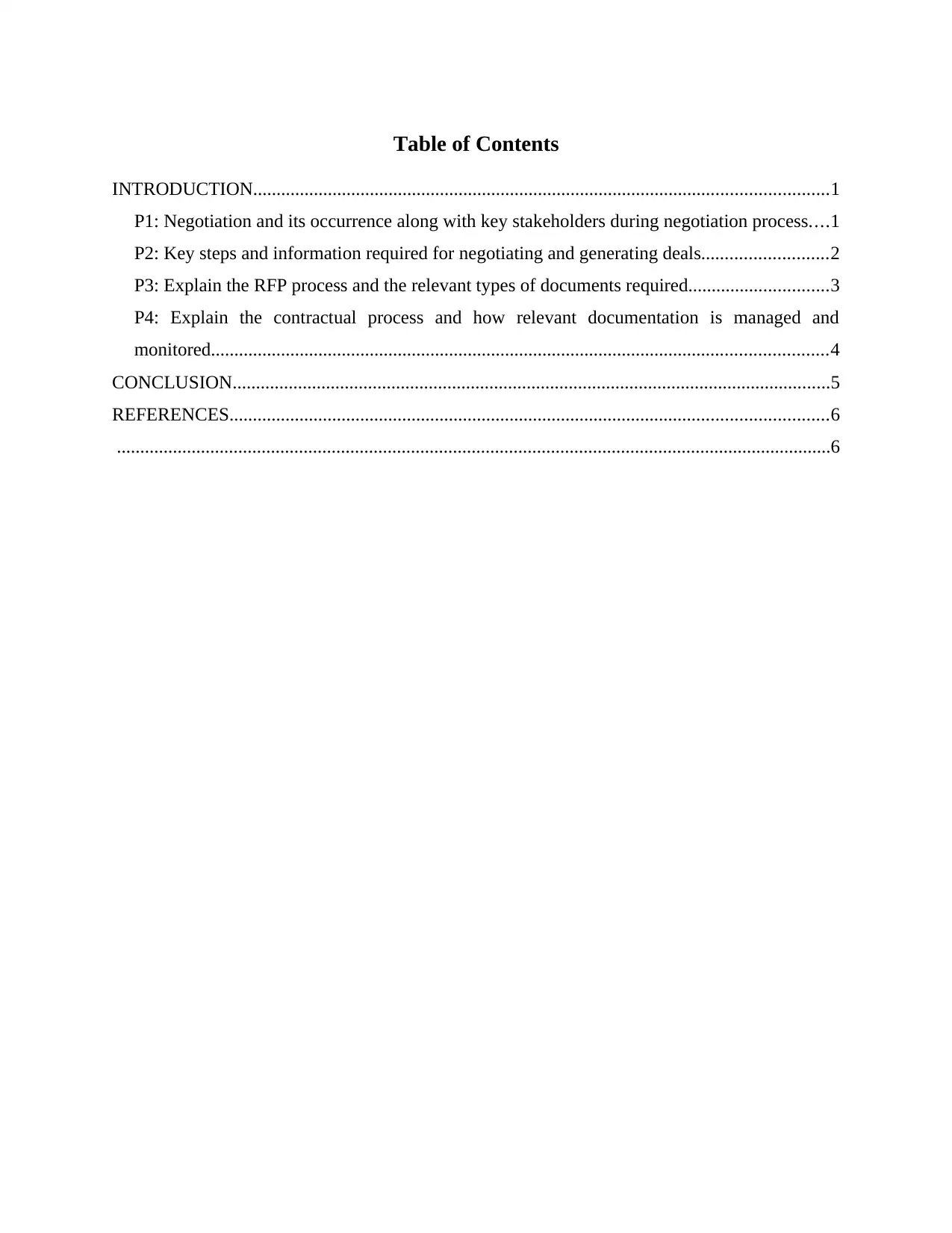
Table of Contents
INTRODUCTION...........................................................................................................................1
P1: Negotiation and its occurrence along with key stakeholders during negotiation process....1
P2: Key steps and information required for negotiating and generating deals...........................2
P3: Explain the RFP process and the relevant types of documents required..............................3
P4: Explain the contractual process and how relevant documentation is managed and
monitored....................................................................................................................................4
CONCLUSION................................................................................................................................5
REFERENCES................................................................................................................................6
.........................................................................................................................................................6
INTRODUCTION...........................................................................................................................1
P1: Negotiation and its occurrence along with key stakeholders during negotiation process....1
P2: Key steps and information required for negotiating and generating deals...........................2
P3: Explain the RFP process and the relevant types of documents required..............................3
P4: Explain the contractual process and how relevant documentation is managed and
monitored....................................................................................................................................4
CONCLUSION................................................................................................................................5
REFERENCES................................................................................................................................6
.........................................................................................................................................................6
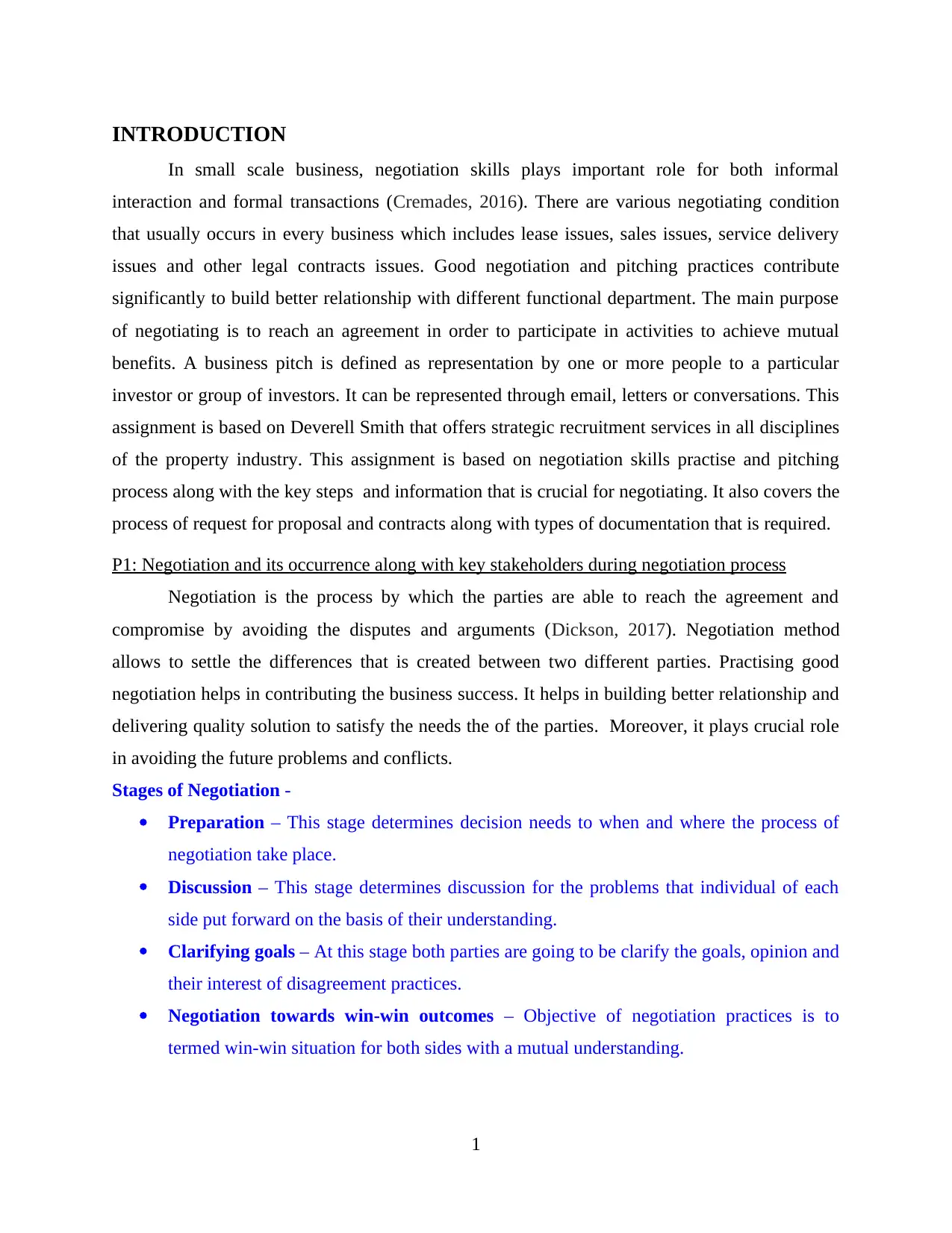
INTRODUCTION
In small scale business, negotiation skills plays important role for both informal
interaction and formal transactions (Cremades, 2016). There are various negotiating condition
that usually occurs in every business which includes lease issues, sales issues, service delivery
issues and other legal contracts issues. Good negotiation and pitching practices contribute
significantly to build better relationship with different functional department. The main purpose
of negotiating is to reach an agreement in order to participate in activities to achieve mutual
benefits. A business pitch is defined as representation by one or more people to a particular
investor or group of investors. It can be represented through email, letters or conversations. This
assignment is based on Deverell Smith that offers strategic recruitment services in all disciplines
of the property industry. This assignment is based on negotiation skills practise and pitching
process along with the key steps and information that is crucial for negotiating. It also covers the
process of request for proposal and contracts along with types of documentation that is required.
P1: Negotiation and its occurrence along with key stakeholders during negotiation process
Negotiation is the process by which the parties are able to reach the agreement and
compromise by avoiding the disputes and arguments (Dickson, 2017). Negotiation method
allows to settle the differences that is created between two different parties. Practising good
negotiation helps in contributing the business success. It helps in building better relationship and
delivering quality solution to satisfy the needs the of the parties. Moreover, it plays crucial role
in avoiding the future problems and conflicts.
Stages of Negotiation -
Preparation – This stage determines decision needs to when and where the process of
negotiation take place.
Discussion – This stage determines discussion for the problems that individual of each
side put forward on the basis of their understanding.
Clarifying goals – At this stage both parties are going to be clarify the goals, opinion and
their interest of disagreement practices.
Negotiation towards win-win outcomes – Objective of negotiation practices is to
termed win-win situation for both sides with a mutual understanding.
1
In small scale business, negotiation skills plays important role for both informal
interaction and formal transactions (Cremades, 2016). There are various negotiating condition
that usually occurs in every business which includes lease issues, sales issues, service delivery
issues and other legal contracts issues. Good negotiation and pitching practices contribute
significantly to build better relationship with different functional department. The main purpose
of negotiating is to reach an agreement in order to participate in activities to achieve mutual
benefits. A business pitch is defined as representation by one or more people to a particular
investor or group of investors. It can be represented through email, letters or conversations. This
assignment is based on Deverell Smith that offers strategic recruitment services in all disciplines
of the property industry. This assignment is based on negotiation skills practise and pitching
process along with the key steps and information that is crucial for negotiating. It also covers the
process of request for proposal and contracts along with types of documentation that is required.
P1: Negotiation and its occurrence along with key stakeholders during negotiation process
Negotiation is the process by which the parties are able to reach the agreement and
compromise by avoiding the disputes and arguments (Dickson, 2017). Negotiation method
allows to settle the differences that is created between two different parties. Practising good
negotiation helps in contributing the business success. It helps in building better relationship and
delivering quality solution to satisfy the needs the of the parties. Moreover, it plays crucial role
in avoiding the future problems and conflicts.
Stages of Negotiation -
Preparation – This stage determines decision needs to when and where the process of
negotiation take place.
Discussion – This stage determines discussion for the problems that individual of each
side put forward on the basis of their understanding.
Clarifying goals – At this stage both parties are going to be clarify the goals, opinion and
their interest of disagreement practices.
Negotiation towards win-win outcomes – Objective of negotiation practices is to
termed win-win situation for both sides with a mutual understanding.
1
Secure Best Marks with AI Grader
Need help grading? Try our AI Grader for instant feedback on your assignments.
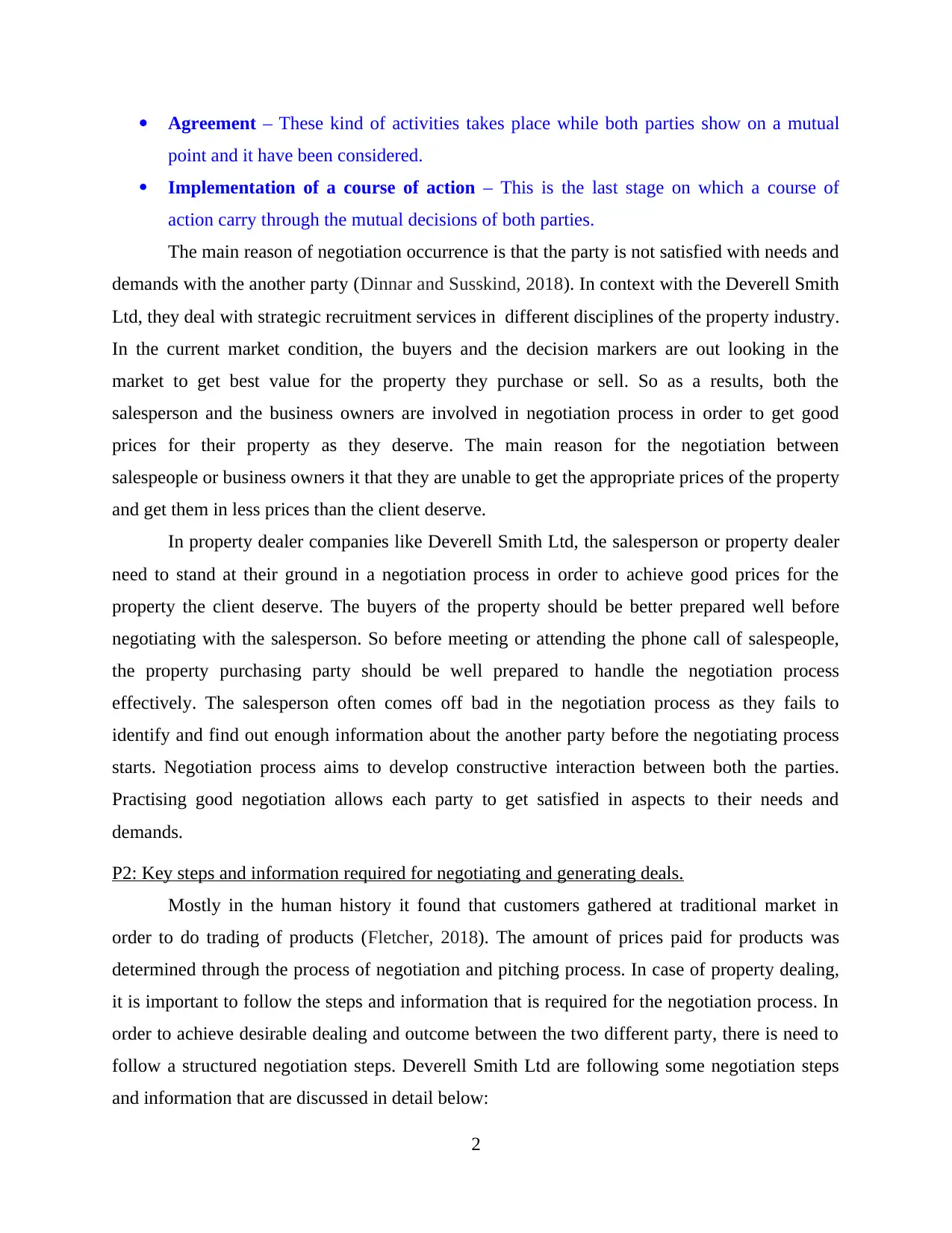
Agreement – These kind of activities takes place while both parties show on a mutual
point and it have been considered.
Implementation of a course of action – This is the last stage on which a course of
action carry through the mutual decisions of both parties.
The main reason of negotiation occurrence is that the party is not satisfied with needs and
demands with the another party (Dinnar and Susskind, 2018). In context with the Deverell Smith
Ltd, they deal with strategic recruitment services in different disciplines of the property industry.
In the current market condition, the buyers and the decision markers are out looking in the
market to get best value for the property they purchase or sell. So as a results, both the
salesperson and the business owners are involved in negotiation process in order to get good
prices for their property as they deserve. The main reason for the negotiation between
salespeople or business owners it that they are unable to get the appropriate prices of the property
and get them in less prices than the client deserve.
In property dealer companies like Deverell Smith Ltd, the salesperson or property dealer
need to stand at their ground in a negotiation process in order to achieve good prices for the
property the client deserve. The buyers of the property should be better prepared well before
negotiating with the salesperson. So before meeting or attending the phone call of salespeople,
the property purchasing party should be well prepared to handle the negotiation process
effectively. The salesperson often comes off bad in the negotiation process as they fails to
identify and find out enough information about the another party before the negotiating process
starts. Negotiation process aims to develop constructive interaction between both the parties.
Practising good negotiation allows each party to get satisfied in aspects to their needs and
demands.
P2: Key steps and information required for negotiating and generating deals.
Mostly in the human history it found that customers gathered at traditional market in
order to do trading of products (Fletcher, 2018). The amount of prices paid for products was
determined through the process of negotiation and pitching process. In case of property dealing,
it is important to follow the steps and information that is required for the negotiation process. In
order to achieve desirable dealing and outcome between the two different party, there is need to
follow a structured negotiation steps. Deverell Smith Ltd are following some negotiation steps
and information that are discussed in detail below:
2
point and it have been considered.
Implementation of a course of action – This is the last stage on which a course of
action carry through the mutual decisions of both parties.
The main reason of negotiation occurrence is that the party is not satisfied with needs and
demands with the another party (Dinnar and Susskind, 2018). In context with the Deverell Smith
Ltd, they deal with strategic recruitment services in different disciplines of the property industry.
In the current market condition, the buyers and the decision markers are out looking in the
market to get best value for the property they purchase or sell. So as a results, both the
salesperson and the business owners are involved in negotiation process in order to get good
prices for their property as they deserve. The main reason for the negotiation between
salespeople or business owners it that they are unable to get the appropriate prices of the property
and get them in less prices than the client deserve.
In property dealer companies like Deverell Smith Ltd, the salesperson or property dealer
need to stand at their ground in a negotiation process in order to achieve good prices for the
property the client deserve. The buyers of the property should be better prepared well before
negotiating with the salesperson. So before meeting or attending the phone call of salespeople,
the property purchasing party should be well prepared to handle the negotiation process
effectively. The salesperson often comes off bad in the negotiation process as they fails to
identify and find out enough information about the another party before the negotiating process
starts. Negotiation process aims to develop constructive interaction between both the parties.
Practising good negotiation allows each party to get satisfied in aspects to their needs and
demands.
P2: Key steps and information required for negotiating and generating deals.
Mostly in the human history it found that customers gathered at traditional market in
order to do trading of products (Fletcher, 2018). The amount of prices paid for products was
determined through the process of negotiation and pitching process. In case of property dealing,
it is important to follow the steps and information that is required for the negotiation process. In
order to achieve desirable dealing and outcome between the two different party, there is need to
follow a structured negotiation steps. Deverell Smith Ltd are following some negotiation steps
and information that are discussed in detail below:
2
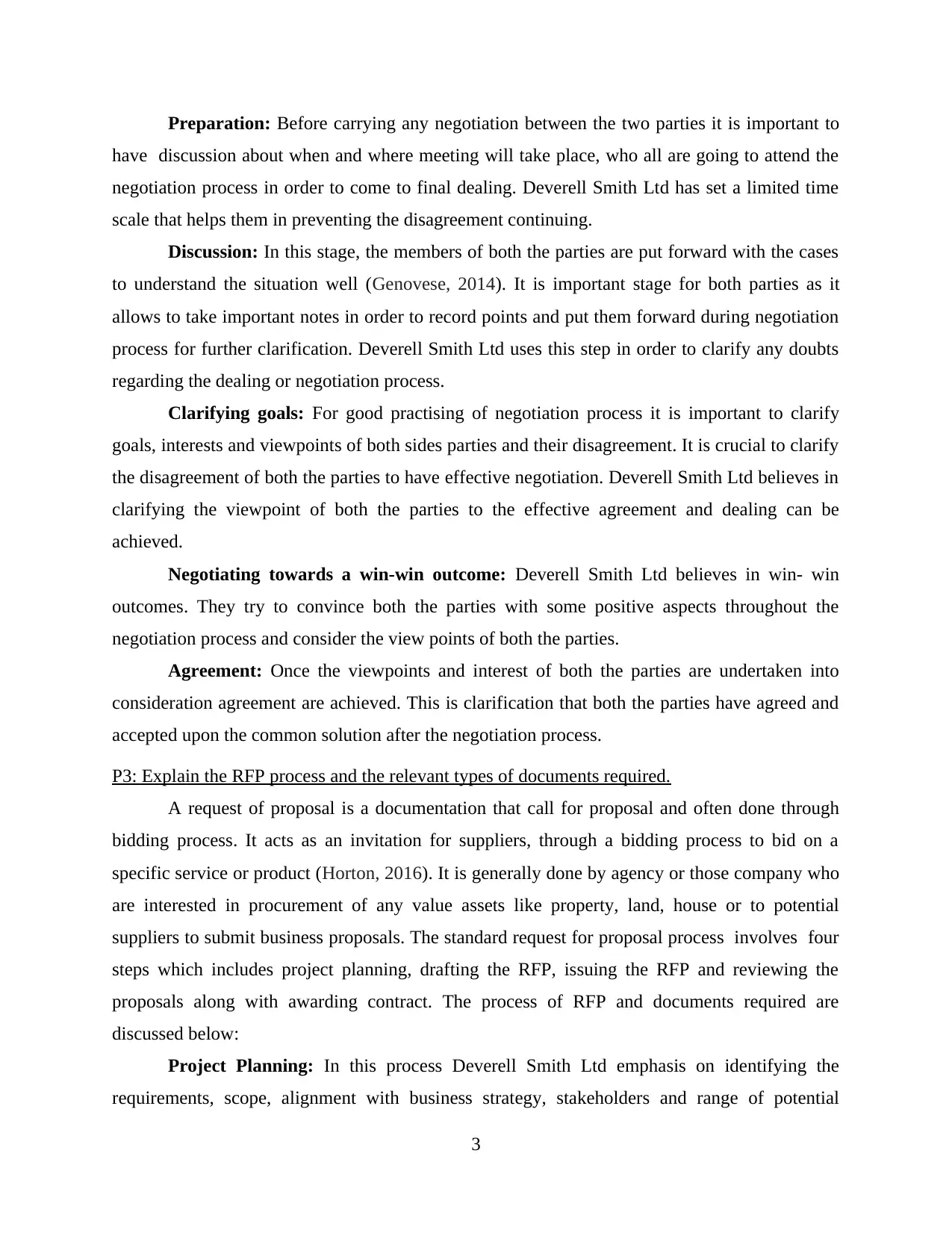
Preparation: Before carrying any negotiation between the two parties it is important to
have discussion about when and where meeting will take place, who all are going to attend the
negotiation process in order to come to final dealing. Deverell Smith Ltd has set a limited time
scale that helps them in preventing the disagreement continuing.
Discussion: In this stage, the members of both the parties are put forward with the cases
to understand the situation well (Genovese, 2014). It is important stage for both parties as it
allows to take important notes in order to record points and put them forward during negotiation
process for further clarification. Deverell Smith Ltd uses this step in order to clarify any doubts
regarding the dealing or negotiation process.
Clarifying goals: For good practising of negotiation process it is important to clarify
goals, interests and viewpoints of both sides parties and their disagreement. It is crucial to clarify
the disagreement of both the parties to have effective negotiation. Deverell Smith Ltd believes in
clarifying the viewpoint of both the parties to the effective agreement and dealing can be
achieved.
Negotiating towards a win-win outcome: Deverell Smith Ltd believes in win- win
outcomes. They try to convince both the parties with some positive aspects throughout the
negotiation process and consider the view points of both the parties.
Agreement: Once the viewpoints and interest of both the parties are undertaken into
consideration agreement are achieved. This is clarification that both the parties have agreed and
accepted upon the common solution after the negotiation process.
P3: Explain the RFP process and the relevant types of documents required.
A request of proposal is a documentation that call for proposal and often done through
bidding process. It acts as an invitation for suppliers, through a bidding process to bid on a
specific service or product (Horton, 2016). It is generally done by agency or those company who
are interested in procurement of any value assets like property, land, house or to potential
suppliers to submit business proposals. The standard request for proposal process involves four
steps which includes project planning, drafting the RFP, issuing the RFP and reviewing the
proposals along with awarding contract. The process of RFP and documents required are
discussed below:
Project Planning: In this process Deverell Smith Ltd emphasis on identifying the
requirements, scope, alignment with business strategy, stakeholders and range of potential
3
have discussion about when and where meeting will take place, who all are going to attend the
negotiation process in order to come to final dealing. Deverell Smith Ltd has set a limited time
scale that helps them in preventing the disagreement continuing.
Discussion: In this stage, the members of both the parties are put forward with the cases
to understand the situation well (Genovese, 2014). It is important stage for both parties as it
allows to take important notes in order to record points and put them forward during negotiation
process for further clarification. Deverell Smith Ltd uses this step in order to clarify any doubts
regarding the dealing or negotiation process.
Clarifying goals: For good practising of negotiation process it is important to clarify
goals, interests and viewpoints of both sides parties and their disagreement. It is crucial to clarify
the disagreement of both the parties to have effective negotiation. Deverell Smith Ltd believes in
clarifying the viewpoint of both the parties to the effective agreement and dealing can be
achieved.
Negotiating towards a win-win outcome: Deverell Smith Ltd believes in win- win
outcomes. They try to convince both the parties with some positive aspects throughout the
negotiation process and consider the view points of both the parties.
Agreement: Once the viewpoints and interest of both the parties are undertaken into
consideration agreement are achieved. This is clarification that both the parties have agreed and
accepted upon the common solution after the negotiation process.
P3: Explain the RFP process and the relevant types of documents required.
A request of proposal is a documentation that call for proposal and often done through
bidding process. It acts as an invitation for suppliers, through a bidding process to bid on a
specific service or product (Horton, 2016). It is generally done by agency or those company who
are interested in procurement of any value assets like property, land, house or to potential
suppliers to submit business proposals. The standard request for proposal process involves four
steps which includes project planning, drafting the RFP, issuing the RFP and reviewing the
proposals along with awarding contract. The process of RFP and documents required are
discussed below:
Project Planning: In this process Deverell Smith Ltd emphasis on identifying the
requirements, scope, alignment with business strategy, stakeholders and range of potential
3
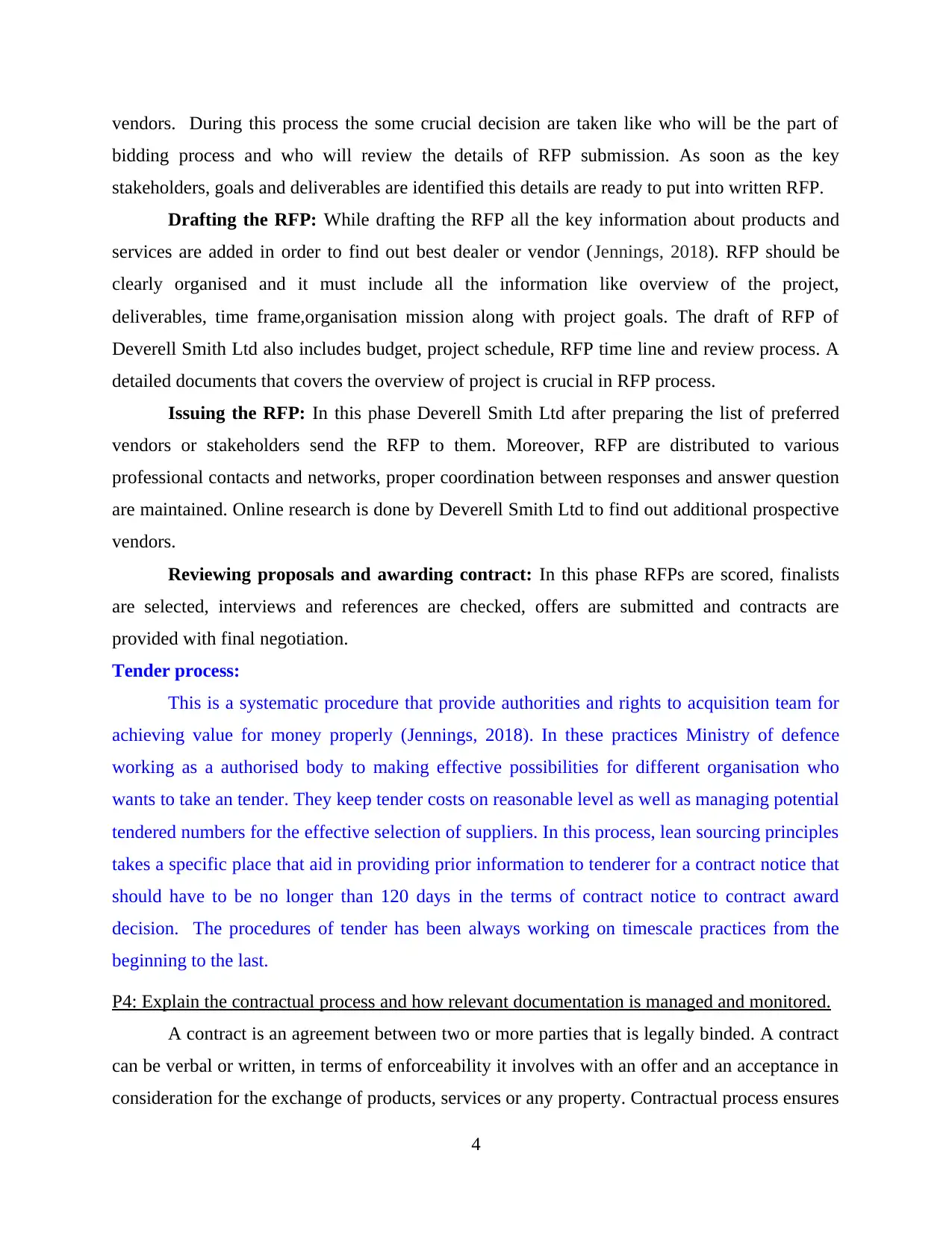
vendors. During this process the some crucial decision are taken like who will be the part of
bidding process and who will review the details of RFP submission. As soon as the key
stakeholders, goals and deliverables are identified this details are ready to put into written RFP.
Drafting the RFP: While drafting the RFP all the key information about products and
services are added in order to find out best dealer or vendor (Jennings, 2018). RFP should be
clearly organised and it must include all the information like overview of the project,
deliverables, time frame,organisation mission along with project goals. The draft of RFP of
Deverell Smith Ltd also includes budget, project schedule, RFP time line and review process. A
detailed documents that covers the overview of project is crucial in RFP process.
Issuing the RFP: In this phase Deverell Smith Ltd after preparing the list of preferred
vendors or stakeholders send the RFP to them. Moreover, RFP are distributed to various
professional contacts and networks, proper coordination between responses and answer question
are maintained. Online research is done by Deverell Smith Ltd to find out additional prospective
vendors.
Reviewing proposals and awarding contract: In this phase RFPs are scored, finalists
are selected, interviews and references are checked, offers are submitted and contracts are
provided with final negotiation.
Tender process:
This is a systematic procedure that provide authorities and rights to acquisition team for
achieving value for money properly (Jennings, 2018). In these practices Ministry of defence
working as a authorised body to making effective possibilities for different organisation who
wants to take an tender. They keep tender costs on reasonable level as well as managing potential
tendered numbers for the effective selection of suppliers. In this process, lean sourcing principles
takes a specific place that aid in providing prior information to tenderer for a contract notice that
should have to be no longer than 120 days in the terms of contract notice to contract award
decision. The procedures of tender has been always working on timescale practices from the
beginning to the last.
P4: Explain the contractual process and how relevant documentation is managed and monitored.
A contract is an agreement between two or more parties that is legally binded. A contract
can be verbal or written, in terms of enforceability it involves with an offer and an acceptance in
consideration for the exchange of products, services or any property. Contractual process ensures
4
bidding process and who will review the details of RFP submission. As soon as the key
stakeholders, goals and deliverables are identified this details are ready to put into written RFP.
Drafting the RFP: While drafting the RFP all the key information about products and
services are added in order to find out best dealer or vendor (Jennings, 2018). RFP should be
clearly organised and it must include all the information like overview of the project,
deliverables, time frame,organisation mission along with project goals. The draft of RFP of
Deverell Smith Ltd also includes budget, project schedule, RFP time line and review process. A
detailed documents that covers the overview of project is crucial in RFP process.
Issuing the RFP: In this phase Deverell Smith Ltd after preparing the list of preferred
vendors or stakeholders send the RFP to them. Moreover, RFP are distributed to various
professional contacts and networks, proper coordination between responses and answer question
are maintained. Online research is done by Deverell Smith Ltd to find out additional prospective
vendors.
Reviewing proposals and awarding contract: In this phase RFPs are scored, finalists
are selected, interviews and references are checked, offers are submitted and contracts are
provided with final negotiation.
Tender process:
This is a systematic procedure that provide authorities and rights to acquisition team for
achieving value for money properly (Jennings, 2018). In these practices Ministry of defence
working as a authorised body to making effective possibilities for different organisation who
wants to take an tender. They keep tender costs on reasonable level as well as managing potential
tendered numbers for the effective selection of suppliers. In this process, lean sourcing principles
takes a specific place that aid in providing prior information to tenderer for a contract notice that
should have to be no longer than 120 days in the terms of contract notice to contract award
decision. The procedures of tender has been always working on timescale practices from the
beginning to the last.
P4: Explain the contractual process and how relevant documentation is managed and monitored.
A contract is an agreement between two or more parties that is legally binded. A contract
can be verbal or written, in terms of enforceability it involves with an offer and an acceptance in
consideration for the exchange of products, services or any property. Contractual process ensures
4
Paraphrase This Document
Need a fresh take? Get an instant paraphrase of this document with our AI Paraphraser
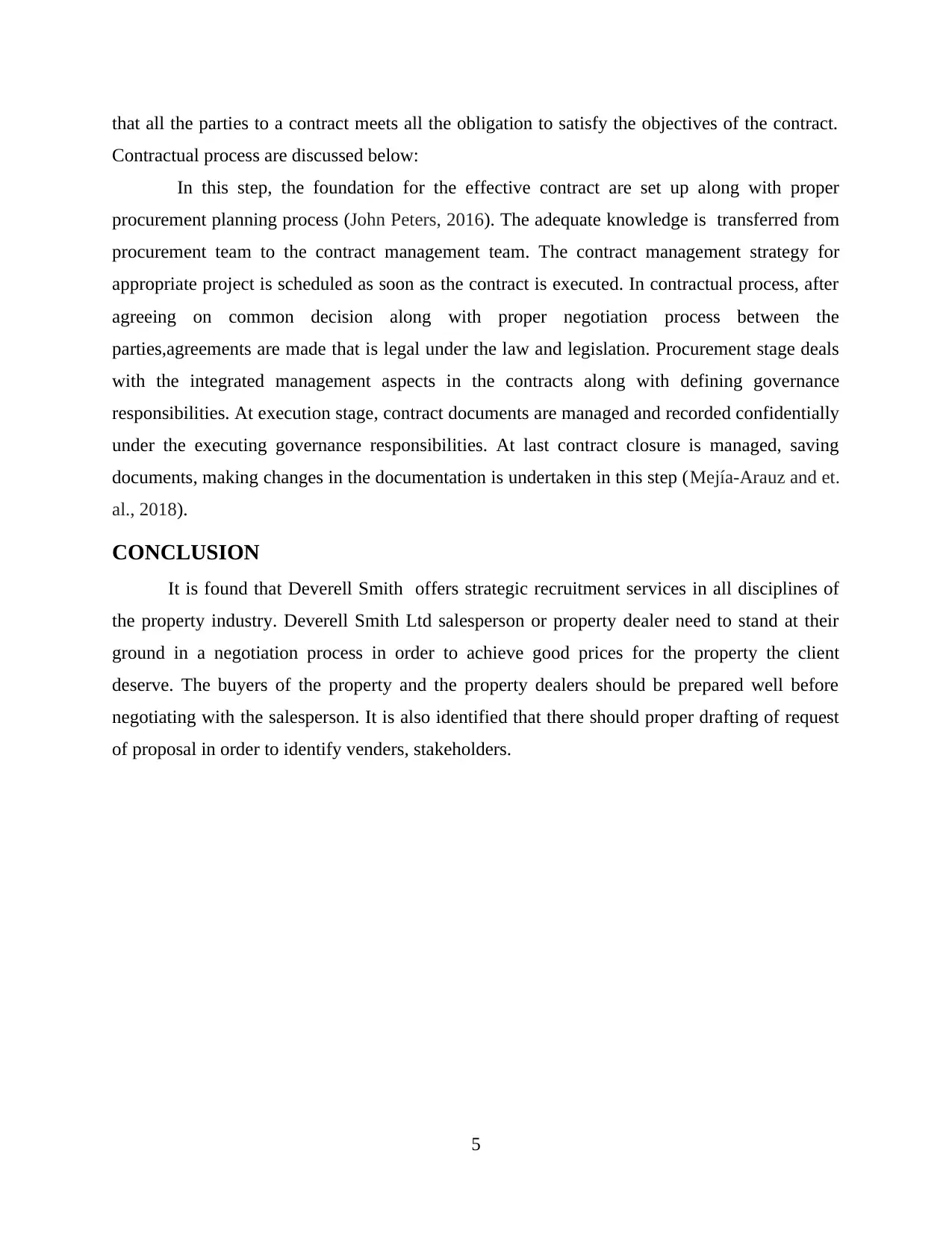
that all the parties to a contract meets all the obligation to satisfy the objectives of the contract.
Contractual process are discussed below:
In this step, the foundation for the effective contract are set up along with proper
procurement planning process (John Peters, 2016). The adequate knowledge is transferred from
procurement team to the contract management team. The contract management strategy for
appropriate project is scheduled as soon as the contract is executed. In contractual process, after
agreeing on common decision along with proper negotiation process between the
parties,agreements are made that is legal under the law and legislation. Procurement stage deals
with the integrated management aspects in the contracts along with defining governance
responsibilities. At execution stage, contract documents are managed and recorded confidentially
under the executing governance responsibilities. At last contract closure is managed, saving
documents, making changes in the documentation is undertaken in this step (Mejía-Arauz and et.
al., 2018).
CONCLUSION
It is found that Deverell Smith offers strategic recruitment services in all disciplines of
the property industry. Deverell Smith Ltd salesperson or property dealer need to stand at their
ground in a negotiation process in order to achieve good prices for the property the client
deserve. The buyers of the property and the property dealers should be prepared well before
negotiating with the salesperson. It is also identified that there should proper drafting of request
of proposal in order to identify venders, stakeholders.
5
Contractual process are discussed below:
In this step, the foundation for the effective contract are set up along with proper
procurement planning process (John Peters, 2016). The adequate knowledge is transferred from
procurement team to the contract management team. The contract management strategy for
appropriate project is scheduled as soon as the contract is executed. In contractual process, after
agreeing on common decision along with proper negotiation process between the
parties,agreements are made that is legal under the law and legislation. Procurement stage deals
with the integrated management aspects in the contracts along with defining governance
responsibilities. At execution stage, contract documents are managed and recorded confidentially
under the executing governance responsibilities. At last contract closure is managed, saving
documents, making changes in the documentation is undertaken in this step (Mejía-Arauz and et.
al., 2018).
CONCLUSION
It is found that Deverell Smith offers strategic recruitment services in all disciplines of
the property industry. Deverell Smith Ltd salesperson or property dealer need to stand at their
ground in a negotiation process in order to achieve good prices for the property the client
deserve. The buyers of the property and the property dealers should be prepared well before
negotiating with the salesperson. It is also identified that there should proper drafting of request
of proposal in order to identify venders, stakeholders.
5
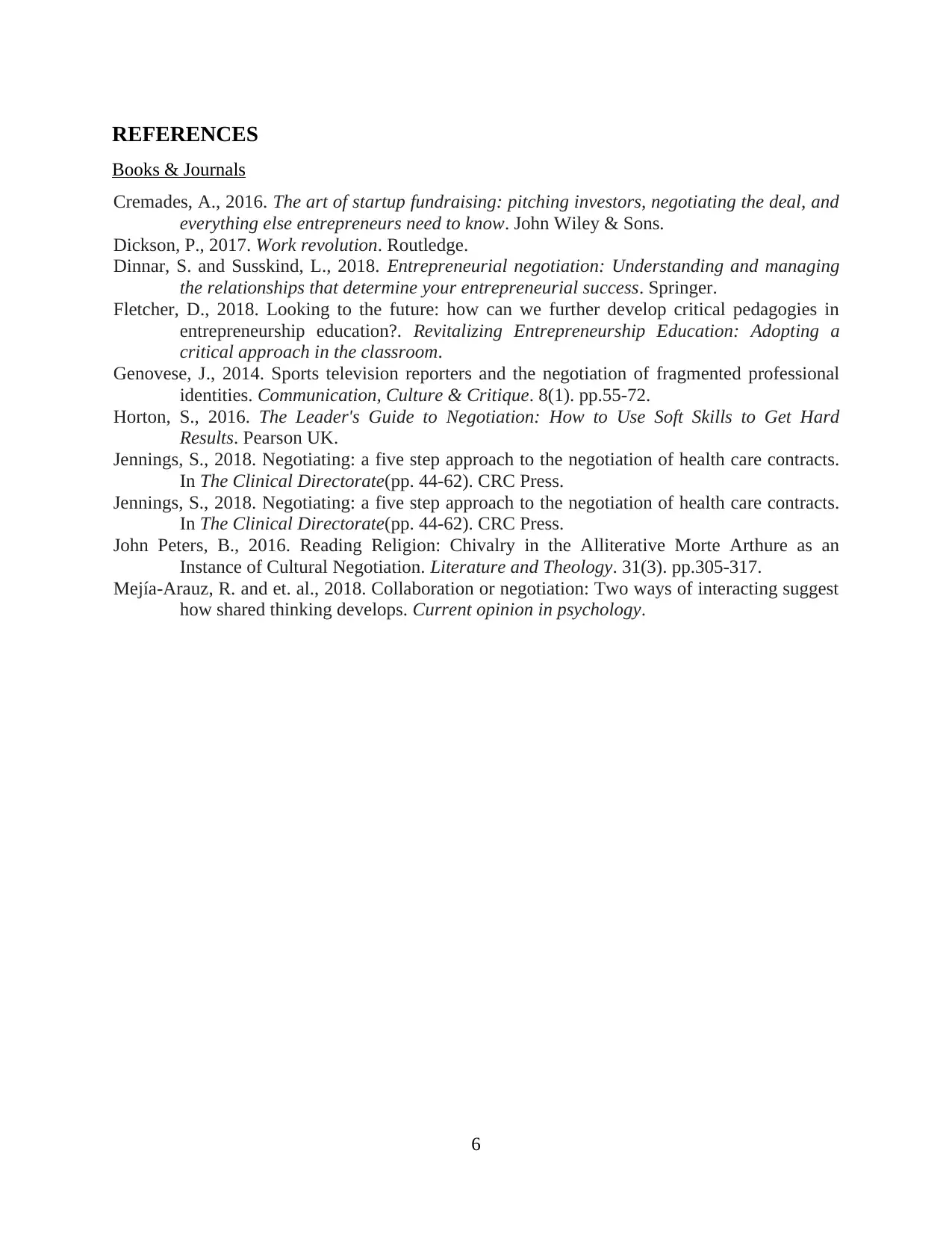
REFERENCES
Books & Journals
Cremades, A., 2016. The art of startup fundraising: pitching investors, negotiating the deal, and
everything else entrepreneurs need to know. John Wiley & Sons.
Dickson, P., 2017. Work revolution. Routledge.
Dinnar, S. and Susskind, L., 2018. Entrepreneurial negotiation: Understanding and managing
the relationships that determine your entrepreneurial success. Springer.
Fletcher, D., 2018. Looking to the future: how can we further develop critical pedagogies in
entrepreneurship education?. Revitalizing Entrepreneurship Education: Adopting a
critical approach in the classroom.
Genovese, J., 2014. Sports television reporters and the negotiation of fragmented professional
identities. Communication, Culture & Critique. 8(1). pp.55-72.
Horton, S., 2016. The Leader's Guide to Negotiation: How to Use Soft Skills to Get Hard
Results. Pearson UK.
Jennings, S., 2018. Negotiating: a five step approach to the negotiation of health care contracts.
In The Clinical Directorate(pp. 44-62). CRC Press.
Jennings, S., 2018. Negotiating: a five step approach to the negotiation of health care contracts.
In The Clinical Directorate(pp. 44-62). CRC Press.
John Peters, B., 2016. Reading Religion: Chivalry in the Alliterative Morte Arthure as an
Instance of Cultural Negotiation. Literature and Theology. 31(3). pp.305-317.
Mejía-Arauz, R. and et. al., 2018. Collaboration or negotiation: Two ways of interacting suggest
how shared thinking develops. Current opinion in psychology.
6
Books & Journals
Cremades, A., 2016. The art of startup fundraising: pitching investors, negotiating the deal, and
everything else entrepreneurs need to know. John Wiley & Sons.
Dickson, P., 2017. Work revolution. Routledge.
Dinnar, S. and Susskind, L., 2018. Entrepreneurial negotiation: Understanding and managing
the relationships that determine your entrepreneurial success. Springer.
Fletcher, D., 2018. Looking to the future: how can we further develop critical pedagogies in
entrepreneurship education?. Revitalizing Entrepreneurship Education: Adopting a
critical approach in the classroom.
Genovese, J., 2014. Sports television reporters and the negotiation of fragmented professional
identities. Communication, Culture & Critique. 8(1). pp.55-72.
Horton, S., 2016. The Leader's Guide to Negotiation: How to Use Soft Skills to Get Hard
Results. Pearson UK.
Jennings, S., 2018. Negotiating: a five step approach to the negotiation of health care contracts.
In The Clinical Directorate(pp. 44-62). CRC Press.
Jennings, S., 2018. Negotiating: a five step approach to the negotiation of health care contracts.
In The Clinical Directorate(pp. 44-62). CRC Press.
John Peters, B., 2016. Reading Religion: Chivalry in the Alliterative Morte Arthure as an
Instance of Cultural Negotiation. Literature and Theology. 31(3). pp.305-317.
Mejía-Arauz, R. and et. al., 2018. Collaboration or negotiation: Two ways of interacting suggest
how shared thinking develops. Current opinion in psychology.
6
1 out of 9
Related Documents
Your All-in-One AI-Powered Toolkit for Academic Success.
+13062052269
info@desklib.com
Available 24*7 on WhatsApp / Email
![[object Object]](/_next/static/media/star-bottom.7253800d.svg)
Unlock your academic potential
© 2024 | Zucol Services PVT LTD | All rights reserved.





